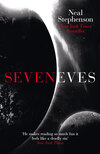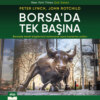Kitabı oku: «Seveneves», sayfa 8
Pioneers and Prospectors
“THE ICEMAN COMETH.”
“Ah.” Rhys sighed. “I was wondering which of us would be first to go there.” He pulled out, drifted away, and did a peel-and-knot on the condom so expertly that it created dark stirrings of jealousy in Dinah’s heart. But at least he didn’t let anything get loose in Dinah’s shop.
“This may have been your last delivery,” Dinah said. “Of ice, that is.”
“You’ve got your freezer?”
“Coming up on tomorrow’s launch from Kourou.”
“Any chance of getting them to send up a martini shaker with it?”
“We use plastic bags for that.”
“Well, I hope that my deliveries—of ice, that is—have contributed something to whatever the hell you’ve been doing.”
“Check this out,” she said. She’d already wrapped herself in a blanket, but now she prodded the wall with a toe and drifted over to her workstation. With a bit of clicking around she brought up a video. The opening shot was stark: a cube of ice in a black chamber, lit up by bright but cold LEDs.
“From Arjuna HQ, I presume?” Rhys, still naked, came up behind her and wrapped an arm around her waist. She liked to think of it as an affectionate gesture. In part it was. But she’d been in zero gee long enough to understand that he also just didn’t want to drift away while watching the movie.
“Yes.”
A bearded strawberry-blond man entered the frame carrying a sheet of corrugated cardboard—the lid of a pizza box.
“That’s Larz Hoedemaeker, I think—one of the guys I’ve been working with a lot.”
Larz angled the pizza lid slightly toward the camera. It was mostly covered by iridescent fingernail-sized objects, like silicon beetles. Hundreds of them.
“That’s a lot of Nats,” Rhys remarked.
“Well … the whole point is to make a swarm.”
“I understand. But it seems they’ve found a way to ramp up production.”
Larz folded the cardboard diagonally to make it into a crude trough and then angled it down toward the block of ice. The Nats avalanched down and tumbled onto it in a heap. Quite a few of them skittered off and tumbled onto the floor. Larz exited the frame for a moment, then returned, pushing a wheeled swivel chair. He arranged this behind the block of ice, then disappeared again, then came back carrying a clock that he had apparently just taken down from the wall of an office. He balanced this on the seat of the swivel chair, leaning back against its lumbar support, so that it was clearly visible in the frame of the video. Then he departed.
A few moments later the lights got much brighter. “Simulating solar radiation,” Dinah explained. “The Nats are solar powered, so the only way to test them is to have a light source as bright as the sun.”
The clock’s minute hand now began to sweep forward. “Time lapse?” Rhys asked.
“Yeah. This stuff happens slowly, as you’ve seen.”
The Nats that had scattered to the floor scurried around aimlessly for a bit, then seemed to find the block of ice, and scaled its vertical sides. “Pretty good adhesion, you’ll note,” Dinah said.
Meanwhile the heap of Nats on top spread out like a pat of butter softening on a pancake, distributing themselves in a somewhat random but basically even layer atop the ice block. A few of them appeared to sink into the ice. “Melting their way in?” Rhys asked.
“No. Uses too much energy—and wouldn’t work in zero gee. They are mechanically tunneling. See the piles forming?” She pointed to the top of the ice block, where mounds of white had begun to form around the exits of the tunnels. “That is spoil being carved out and ejected by the tunneling Nats.”
“You can’t make mounds in zero gee either,” Rhys pointed out.
“One thing at a time!” she said, elbowing him. “The other guys are working on it, see?” She used the cursor to point out another Nat that was making its way along the surface. It seized hold of some little ice grains from a mound, then backed away and headed toward the edge of the ice block.
“How’s it doing that?” Rhys asked.
“You know how when your hand is wet and you reach into the freezer and pick up an ice cube, it’ll stick to your skin? That’s all there is to it,” Dinah said. “And that is also how they crawl around on the ice without falling off.”
The minute hand on the clock began moving faster, and even the hour hand could be seen sweeping around now. The surface of the ice block became pitted and then began to sink toward the floor as material was removed. But at the same time, one edge of the block developed a bulge that grew into a cantilevered prong, like the horn on an anvil.
“What are they building?” Rhys asked.
“Doesn’t matter. This is just a proof of concept.”
The growth stopped, the clock dial slowed to normal time, another engineer walked in to snap some pictures of the result. Then the video cut away to a black screen.
“Interesting!” Rhys said.
She grabbed his hand before he could get away. “Hang on. Check out the superfast version.”
This started a moment later. It was just the same movie, shown ten times faster. So it only lasted for a few seconds. The Nats were invisible because of the speed of their movement—just a jittery gray fog that came and went in patches. This drew the eye to the block of ice. Shown at this speed, it looked less like a crystalline slab and more like an amoeba, sinking down at one end while smoothly projecting a pseudopod into space.
“One has to assume,” Rhys said, “that there’s a reason why Sean Probst is so very keen on making ice sit up and do tricks for him.”
“Yeah. But he’s not sharing it with me.”
“Is there any way,” he wondered, “of joining those Nats end to end?”
“Into a chain?”
“Yes. The Siwis are serviceable, but much more complicated than they need to be.”
“You have got chains on the brain. Yes, there’s a way. And you can join them side to side to make a sheet.”
“Uncle John is calling to me from beyond the grave, telling me to make something of his hobby.”
“Well, stay in my good graces,” she said, “and I’ll let you play with some.”
DAY 56
As of A+0.56, the Hub module around which the torus spun was no longer the aft-most part of Izzy. They called it H1 now. A larger hub, called H2, had been sent up on a heavy-lift booster from Cape Canaveral and mated with it.
H2 had originally been planned as the basis of a large space tourism operation. Rhys’s original mission, for which he’d been planning and training for two years, had been to get that up and running. It had a new purpose now, of course, but functionally it would look the same: H2, the big central module, with a new and larger torus rotating around it. That new torus, inevitably called T2, was going to be assembled in space from a kit of rigid and inflatable parts, some of which had been shipped up packed inside of H2, others to follow later on subsequent launches. For the time being, H2 had four fat spokes extending from it to terminate in stubs where other parts, forming the rim of the wheel, would be added later.
The Scouts by then had achieved their basic mission, which had been to employ the Integrated Truss Assembly as a backbone to support a tree of hollow pipes, each about fifty centimeters in diameter, with wide spots every ten meters or so. A human being, provided they were reasonably fit, and did not suffer from claustrophobia, and did not have too much stuff in their pockets, could move through a tube of that diameter, somewhat like a hamster scurrying through a plastic tube in a cage. The wide spots were there so that two people going opposite directions could pass each other. Spherical modules served as connectors and branch points. The tubes terminated in docking locations where spacecraft of various types could lock on to the space station and establish solid, airtight seals.
For it had been obvious from the beginning that docking sites were going to be, in the lingo of Pete Starling, “the scarce resource,” “the long pole,” “the critical path.” Building rockets, spacecraft, and space suits was no easy matter, but at least these things happened on the ground, where colossal resources could be thrown into beefing up production. An armada of space capsules hurled into orbit would have nowhere to go, however, unless they could dock somewhere. And the docking sites had to be built the hard way: on site, in orbit.
Docking was no joke, and required specific technology, but it was thoroughly understood and it had been done many times. The Chinese space program had standardized on the same system used by the Russians, so their spacecraft, like the Russians’, could dock at the ISS. So far so good. But the fact remained that every manned spacecraft launched into orbit needed to reach a specific destination within a couple of days’ time, before the occupants ran out of air, food, and water. The task of the Scouts, therefore, had been to vastly increase the number of docks in the quickest and cheapest possible way. Docks couldn’t be too close together, so the distances between them had to be spanned by hamster tubes. Bracketed to the outside surfaces of those tubes, and still being installed by fresh waves of Scouts, were runs of plumbing and wiring, and structural reinforcements tied into the adjacent trusses.
The initial tube tree, built between about A+0.29 and A+0.50 by Tekla and the other first-wave Scouts, sported half a dozen docking locations. These were spoken for immediately by the first wave of so-called Pioneer launches: three Soyuz spacecraft, two Shenzhous, and a space tourism capsule from the United States.
Encouraged by the success of the launch that had carried Bo and Rhys, the Russians had found ways to cram five or six passengers on each Soyuz.
The Shenzhou spacecraft was based on the Soyuz design, except larger, and updated in various ways. Like the Soyuz, it was meant to carry a crew of three—but this was based on the assumption that those three would want to return to Earth alive. Modified for one-way trips, each Shenzhou carried half a dozen. And the American tourist capsule brought a complement of seven astronauts.
So, all told, the first wave of Pioneers brought three dozen people to Izzy, more than doubling its population. They were obliged to live in their space capsules, which had their own toilets, CO2 scrubbers, and heat rejection systems. This made for crowded conditions, but it was a step up from the Luks.
On A+0.56, when the H2 module came up on the giant Falcon Heavy rocket, Tekla and the other surviving Scouts spent a day pulling out all that had been stuffed inside of it and anchoring it temporarily to the outside of the module. They then moved into H2, turning it into a Scout dormitory and saying goodbye to their increasingly tatterdemalion Luks, which were deflated, patched, folded up, and stored for later use in emergencies.
About two-thirds of the Pioneers had previous experience doing EVAs or had been hastily trained over the last few weeks. There were not enough space suits to go around—these were being produced as fast as possible on the ground—but the existing ones could be shared. Work shifts were shortened from fifteen to twelve hours, and then to eight, so that fresh bodies could be rotated through the available suits two or three times a day. The spacewalkers divided their time between assembling the T2 torus and extending the tube trees to provide docking space for the next wave of launches.
The remaining Pioneers, the non-spacewalkers, devoted themselves to other activities inside the pressurized parts of the space station. Dinah found herself with two assistants: Bo, who had seemingly assigned herself to the task, and Larz Hoedemaeker—the guy from the video. Larz was a young Dutch man who had been pursuing a graduate degree in robotics at Delft when he had been recruited by Arjuna Expeditions. Dinah knew him as a prolific email correspondent, always willing to answer her questions or supply code patches on short notice. Owing to some lapse in communications, she hadn’t even known that he would be one of the passengers on the American tourist capsule that had arrived on Day 52 (for people were now dropping the A+ notation and simply referring to days by their numbers).
All she knew was that a large strawberry-blond man suddenly appeared in her shop, intent on hugging her. This was unusual. To put it mildly, the International Space Station, until now, had never been the kind of place for surprise visits.
Larz had a fistful of chocolate bars in one hand and a camera in the other, and all manner of stuff was spilling out of the pockets of his coverall: vials of morphine, antibiotics, reels of microchips on paper tape, disposable contact lenses, condoms, packets of dehydrated coffee, tubes of exotic lubricants, spare leads for mechanical pencils, bundles of zip ties. The policy now seemed to be that everyone being packed onto a ship first had to be so laden down with vitamins that they could hardly move.
Larz was an enjoyable person, and his first day on Izzy was pure fun for Dinah, who had not been able to have a face-to-face conversation with a colleague in a year. She showed him around the shop, such as it was, and let him drive robots around on the surface of Amalthea, and brought a few of her “Grimmed” robots in so that he could admire them. For, inspired by Rhys’s comment of a few weeks ago, Dinah had been putting her otherwise idle robots to work making armor for other robots. The orderly way to do it would have been to bring pieces of the asteroid back to her little zero-gee smelter and produce nice little ingots of pure steel, then weld them onto the frames of the Grabbs. But this was making things too complicated. Amalthea was already made out of perfectly sound material. Maybe it was not structural-grade steel, but it was good enough to serve as radiation shielding. So she had just been slicing pieces of it off, leaving them in their original rough shape, and armoring Grabbs with overlapping plates of the stuff. They looked like walking asteroids now.
“It is an art project,” Larz said. For a moment she thought he was trying to insult her. Because she had met a few engineers in her day who never would have combined art and engineering. But his face was happy and guileless, and it was clear that he was paying her a compliment.
Once she’d gotten a bit used to him, she broached the subject that had been on her mind now for several weeks: Why ice? Given that they had direct access to a giant chunk of iron, why was Arjuna now putting all of its efforts into working with a material that for all practical purposes didn’t exist on Izzy?
“Some things are not always explained to me,” Larz said, “but you know that we have talked for some time about going after a comet core.”
“Sure,” Dinah said. “We’ve talked about it. But those things are huge. What are we going to do with a few gigatons of water?”
Larz just blinked and looked mildly uneasy.
“It would take forever to move something that big!” Dinah said. “It is, like, a ten or twenty-year project! We don’t have that much time.”
“Under the old conditions, yes.”
“What do you mean, the old conditions?”
“Back in the day—before the Agent—when we talked about moving comets, we were talking about sending up a big mirror. Focusing the sun’s light on the comet core, boiling off a little water, pushing it slowly to a new trajectory. Yes. That would take a long time. Like pushing a bowling ball with a feather.”
“And what about that has changed?” Dinah asked. “Physics is physics.”
“Yes,” Larz said, “and some physics is nuclear physics.”
“We’re going to use nukes? I thought that was—Jesus. I don’t even …”
“You don’t appreciate how much things have changed down there,” Larz said.
“I guess not!”
“The Arkitects came out and said, ‘Listen, there is no way of making this work with solar cells. We can’t make enough of them, fast enough, for thousands of arklets. They are big and cumbersome.’”
“I’d been wondering about that.”
“We have to use nukes, is what they said.”
“RTGs?”
Radioisotope thermoelectric generators were the power units used to run most space probes. At the heart of each was a puck of an isotope so radioactive that it remained hot for decades. Energy could be extracted from that heat in various ways.
“Those are not nearly powerful enough,” Larz said.
LARZ GOT MESSAGES FROM THE GROUND IN THE FORM OF ENCRYPTED email, a spate of capital letters in groups of five that looked like something straight out of an Enigma message. In the big nylon wallet that, for Larz, passed as a briefcase was a stack of pages. On each of these was printed a different grid of random capital letters. About half an hour of laborious pencil-and-paper work went into decrypting each message. Dinah couldn’t believe her eyes. People used crypto all the time to send email, of course, and it was standard practice for all Arjuna Expeditions email to be enciphered. But apparently that was no longer good enough for Sean Probst. Dinah got used to seeing Larz toiling over these sheets. He wrote a little Python script to make it easier, but he still wrote the messages out by hand.
One day, two weeks after he’d arrived, he decrypted a message with some surprising news. The boss was coming. As in, Sean Probst, the founder and CEO of Arjuna Expeditions.
“How can that even happen?” Dinah asked. “How can anyone just come up to Izzy? Don’t you need a launch vehicle? A spacecraft? A place to dock it? Permission?!”
These were largely rhetorical questions. Sean had made seven billion dollars from an Internet startup before throwing his energies into asteroid mining. Along the way he’d sunk a billion or two into other private space startups.
“He’s coming up alone,” Larz said, “in a Drop Top.”
It took Dinah a moment, and a quick Google search, to access the memory. Also referred to as “the Convertible,” the Drop Top was one of the more creative recent approaches to space tourism. It was based on the idea that what tourists really wanted to experience was the direct view of the Earth, the stars, and (until it had ceased to exist) the moon. Conventional space capsules had tiny windows. What you really wanted to do was stick your head into a transparent bubble so that you could enjoy a clear view out in all directions. In other words, you wanted to be in a space suit, basically floating free in space. The Drop Top was a small, simple capsule, capable of carrying four astronauts, dressed in custom-made space suits with bubble helmets. During the ascent through the atmosphere, and the reentry, they were protected by a sturdy aeroshell. But while they were orbiting the Earth, the shell retracted, like the roof of a convertible, exposing them completely to space, and even giving them some freedom to spacewalk.
“I don’t think a Drop Top can reach an orbit this high, can it?” Dinah asked.
“Sean’s coming up alone. It is some kind of special one-passenger model—the extra mass is being used for propellant.”
“And then what? He just goes to an airlock and knocks on the door?”
“Basically, yes,” Larz said. “What will they do? Tell him to go away?”
DAY 68
“This whole thing is bullshit,” said Sean Probst as soon as he got his helmet off.
Dinah smiled. It was not that she was happy about the bullshit. When it came to preserving the human race and the genetic heritage of the Earth from destruction, any whiff of bullshit was bad. But she did feel a certain sense of relief. In the back of her mind she had been quietly tallying up the BS for weeks now. No one else here would speak of it, and most of them seemed smarter, better informed than she was.
She knew Sean Probst by his reputation, by his signature on her paychecks, and by the emails he sent her at three o’clock in the morning of whatever time zone his private jet had most recently taken him to. Sean yielded to no one in his knowledge of all things space related. When he walked into a space station and called bullshit, things were about to become entertaining.
One of the few appealing things about him was that he had figured out that his personality was a problem and, in classic “get it done” style, had hired a coach to make him less of an asshole. She could see that working in his face.
“Not your part of it—that’s awesome,” he admitted.
“I figured you would have said something earlier if that were not the case,” Dinah said.
Sean nodded. Done.
His arrival at the space station had been unconventional, and roundabout. There was no docking station to accommodate the Drop Top. There couldn’t possibly be, since the Drop Top didn’t even have a port or an airlock. So there’d been no way to attach it to Izzy. He had brought the little convertible in under manual control, tapping the thrusters one at a time, spitting bullets of spent propellant into space, then pausing for one, five, or ten minutes to ponder the consequences. Space nerd that he was, he knew perfectly well that orbital mechanics did not obey the rules of earthbound physics. He had enough humility, and enough spare oxygen, to take it slow. Eventually he had drifted close enough to Amalthea that a three-Siwi train with a Grabb on its head had been able to reach out and grapple a fitting on the edge of his cockpit. He had then ejected himself from the vehicle, floating free in space, and gone on a little tour of inspection, firing off occasional messages to Dinah so that she could know where he was. Since there was no direct radio connection, these had to be relayed through a server in Seattle.
He was in a tubesuit: a tourist product that in some ways was less capable, in others more so, than the government-issue ones used by cosmonauts and astronauts. It had no legs at all, since legs were pretty useless in space. It looked like a test tube with a pair of arms and a bubble-shaped dome on the top. The arms had shoulder and elbow joints, but no hands as such. Gloves were notoriously the most troublesome parts of space suits. Instead, the tubesuit’s arms terminated in rounded-off stumps. Projecting from each of these was a skeletal hand consisting of a thumb and three fingers, actuated by steel cables that ran through airtight fittings into the arm-stumps. The occupant could slip his hand into a glovelike contraption inside the stump that would pull on the metal tendons as he moved his fingers, thereby actuating the external digits and enabling him to grab things and perform a few simple operations. There was nothing about it that couldn’t have been built by a tinkerer in an inventor’s lab in 1890, or 1690 for that matter. People who had used them reported that they worked surprisingly well—better in some ways than conventional space suit gloves, which were stiff and fatigued the hands.
There was plenty of extra room inside the stumps, and so when not using the clawlike hands he could pull his fingers free of the internal glove and let them rest on internal touchpads and joysticks where he could type and swipe to his heart’s content. The suit had some tiny thrusters that enabled the user to “fly” it around. Sean had put these to work at some length, wandering around the outside of Izzy and inspecting the work of the robots, the modifications made to the truss, and other curiosities.
Finally he had found his way to an airlock at the aft end of H2, where Dinah had let him in, and he had blurted out his opinion.
He looked like any nondescript thirty-eight-year-old nerd at a graduate physics seminar or a sci-fi convention, with stringy dishwater-blond hair stuck to his head by sweat, and a few days’ darker stubble. In his official photos he wore contacts, but today he wore thick-lensed eyeglasses. He pulled one arm, then the other, out of the suit and then pushed himself up and out through the big opening at its top where the head-dome had been attached.
“I’ve been having trouble seeing the long-term sustainability angle,” Dinah admitted. For she was not above dangling bait.
“Ya think?!” he shouted. “Has anyone done even the most basic mass balance calculation on this Cloud Ark concept?” Sean was from New Jersey.
She wasn’t sure what he meant, so she stalled for time. “People have been pretty distracted. I wouldn’t be the first to know.”
“They wouldn’t tell you!” he shouted. “Because you would see right away that it is bullshit!”
“What is?” Ivy asked, floating toward them with an interested look on her face. “And who the hell are you?”
Before Sean could explain who the hell he was, he was distracted, to put it mildly, by the appearance of a six-foot-tall Amazon with a shaved head and prominent facial scars, headed for him across H2 as if she had been launched out of a cannon. Tekla drove her shoulder into Sean’s midsection, slamming him back against a bulkhead. A moment later she was on him. She grabbed an outstretched arm and put Sean into a joint lock that looked pretty much inescapable.
By now Dinah had spent enough time with Tekla to know that she was a practitioner of Sambo, a Soviet combat martial art with many similarities to jujitsu. Out of idle curiosity, Dinah had watched a few YouTube videos featuring Sambo practitioners in action. But she had never imagined, until now, that it could be done in zero gravity.
Sean had made his entry through H2 because it had a useful assortment of airlocks and docking ports on its aft end. But, unbeknownst to him, H2 had been doing double duty as the dormitory where the surviving Scouts lived. His arrival had awoken Tekla, who was off shift at the moment and had been sleeping in her bag.
Dinah tried to imagine what this encounter must have looked like from Tekla’s point of view. Sean’s arrival was unannounced. Dinah herself hadn’t really known when, or whether, he was going to arrive until the Drop Top had swum into view outside her little window. So, from Tekla’s point of view, this guy was an intruder. And when she’d heard Ivy say “Who the hell are you?” she had realized that his presence on Izzy was completely unauthorized.
“Oh, this is awkward,” Dinah said.
“Tap! Tap!” Sean kept saying. He was slapping Tekla’s leg with his free hand.
“Commander, would you like me to restrain him?” Tekla asked. “What are your orders?”
“He’s not dangerous,” Dinah put in.
“Let him go, Tekla,” Ivy said.
Somewhat reluctantly, Tekla relaxed her grip and allowed Sean to float free. He drifted away from her, sizing her up with a certain degree of bewilderment.
“Sean,” Dinah said, “you’ve already made Tekla’s acquaintance. I would like you to meet Ivy Xiao, commander of this installation. Ivy, say hello to Sean Probst.”
“Hello, Sean Probst,” Ivy said, then turned to look at Dinah. “Did you know he was coming?”
“I had heard rumors,” Dinah said. “But I did not think them firm enough to distract you by repeating them. I am sorry.”
Ivy looked at Sean long enough to make him uncomfortable. Tekla, hovering almost within reach, did much to help supply the hostile atmosphere that Dinah suspected Ivy was reaching for.
“The closest analogy in the law for what I am here is the captain of a ship,” Ivy said. “Do you know the etiquette, Sean, for coming aboard a ship?”
Sean calculated.
“Commander Xiao,” he said, “I humbly and respectfully request permission to come aboard your ship.”
“Permission granted,” she said. “And welcome aboard.”
“Thanks.”
“But!”
“Yes?”
“If anyone asks, you’ll please tell them a little white lie, which is that you requested permission first, and then came aboard.”
“I’m happy to do that,” he said.
“Later on we’ll evolve some sort of common law, I guess. A constitution for this thing.”
“People are working on that, actually,” Sean offered.
“That’s nice. But right now we have nothing of the sort and so we have to be mindful.”
“It is so noted,” Sean said.
“Now,” Ivy said, “you were saying something about bullshit when I interrupted.”
“Commander Xiao,” Sean said, “I have the utmost respect for your past accomplishments and for the work you have been doing.”
“Do you hear a but coming?” Ivy asked Dinah. “I hear a but coming.”
Sean stopped.
“Go on,” Ivy said. For at the end of the day, to go on was what Sean wanted, so they might as well get it over with.
HE WORKED IT OUT FROM FIRST PRINCIPLES ON THE WHITEBOARD IN the Banana. Beginning with the Tsiolkovskii equation, a simple exponential, he developed some simple estimates, which he then developed into an ironclad proof, that the Cloud Ark was bullshit.
Or at least that it had been bullshit until he, Sean Probst, had shown up to address the problems he had noticed. Problems that could only be handled by him personally.
It occurred to Dinah to ask herself whether Sean was really rich anymore.
Rich people no longer kept their wealth in gold. Sean’s wealth was in stock—mostly stock in his own companies. She hadn’t been following the stock market since the Crater Lake announcement, but she’d heard that it had not so much crashed as basically ceased to exist. The whole concept of owning stock didn’t really mean much anymore, at least if you thought of it as a store of value.
But legal structures, police, government agencies, and so on still existed and still enforced the law. The law stated that Sean, by virtue of majority ownership of Arjuna Expeditions, still controlled it. And through overlapping relationships with other space entrepreneurs, he still had enough pull to get himself launched to Izzy. So that counted as wealth of a sort.













